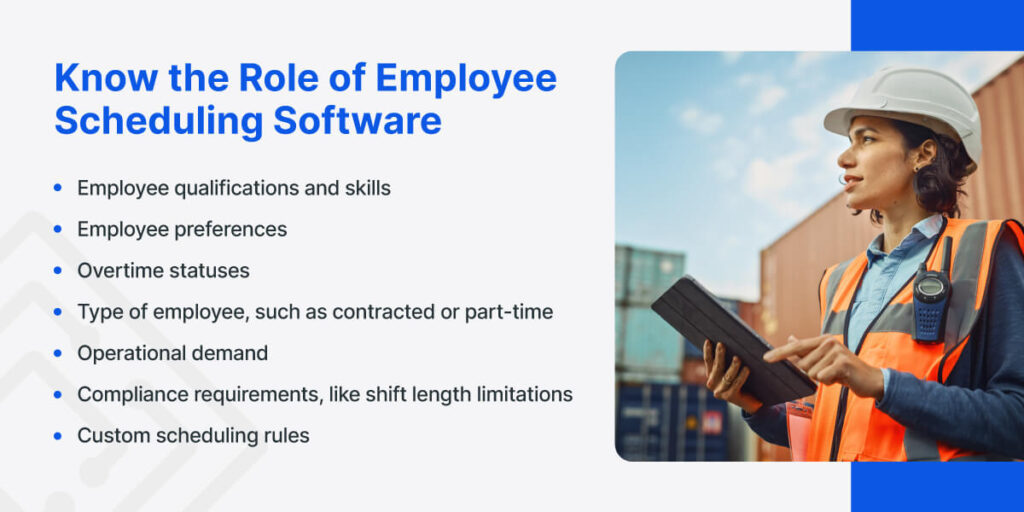Staff shortages can come in many forms. They’re hard to predict, often bringing operations to a halt or significantly reducing your capabilities. Labor shortages in the public sector, for instance, have led to deteriorating roads and increased burnout for the remaining staff, among other problems. Other industries might struggle to meet productivity demands or create safe, compliant work environments.
While addressing a labor crisis requires a multi-faceted approach, one of the most important elements to weathering the storm is establishing a flexible, effective approach to scheduling. Your scheduling strategy can help ensure efficient resource allocation, boost employee retention, save time, and maintain compliance and safety. Other crucial elements of filling staff shortages involve your company culture and general adaptability.
Let’s take a closer look at what is causing staff shortages and how you can overcome them with smarter scheduling.
Identify the Crisis
The first step is noticing the issue. Many factors can contribute to staff shortages, such as:
- Health threats: COVID-19 is a drastic example of a health-related labor crisis, but you may also have problems with other contagious outbreaks, like the seasonal flu that causes half of your team to call out.
- Large amounts of retirees: As the older generation leaves, businesses must focus on hiring efforts to replace them. Some fields, like the public sector, have many older employees, so retirement can create challenges.
- Inflation: The costs of inflation can lead workers away from lower-paying jobs. Even if they’re happy with their positions, the need to pay bills can upend the labor market.
By identifying problems and trends early on, you can take steps to mitigate the damage. To avoid staffing shortages in manufacturing before a busy holiday season, you might hire more workers. For a less predictable crisis, like an illness outbreak, you might call on a cross-trained employee or bring back a retired worker to help fill in the gaps. Even a brief warning can give you enough time to organize your team and avoid being short-staffed.
Know the Role of Employee Scheduling Software
One of the best tools in your arsenal when it comes to staff shortages is employee scheduling software. This task can be time-consuming and ineffective when done manually. The right software automates scheduling and can use countless contextual details that no human can effectively keep track of. For example, Indeavor can use the following pieces of information when making scheduling decisions:
- Employee qualifications and skills
- Employee preferences
- Overtime statuses
- Type of employee, such as contracted or part-time
- Operational demand
- Compliance requirements, like shift length limitations
- Custom scheduling rules
Employee scheduling software can create a schedule that considers these elements and prioritizes them according to your needs and resources. Software programs are especially good at using historical information to inform labor demand planning. This demand-based scheduling approach is an excellent solution to staff shortages. It can help you make strategic, data-driven decisions for your team, all with minimal time commitment.
A scheduling platform can also help you manage a schedule that’s already been released. Say an employee needs to cover a shift for the next day. Instead of waiting until the next morning when the hiring manager is in, the worker can use a self-service app to trade shifts with another employee. The covering employee has more of a heads-up, the hiring manager saves time, and the day is less chaotic for everyone.
End-to-end programs can even support reporting and integration with other systems, such as human capital management and enterprise resource planning platforms.

Adapt Schedules in Times of Crisis
Staying flexible can make all the difference in responding to scheduling crisis’s, such as staff shortages. If you’re short-staffed, you may need to make adjustments, such as increasing a part-time employee’s hours or cross-training a worker in another department. When the day gets hectic, arranging these changes can be difficult. The right tools help you respond quickly.
Software simplifies the process of changing schedules and accommodating new work arrangements. They might help you identify workers who want more hours, can be cross-trained, can work remotely, or are nearing overtime status. As you make changes, your system looks out for potential problems, like a schedule violating safety laws or employees who would go into overtime.
Solving labor shortages can get complicated, especially when credentials are involved. Compliance can also add complexity in industries like government and manufacturing, which may have strict laws and union agreements to meet. Software can help you become more flexible and adapt to whatever challenges come your way.
Ensure Real-Time Communication and Transparency
As you adapt, you’ll need to communicate in real time and create transparency around your scheduling practices. Better communication and visibility can allow employees to take action and minimize misunderstandings, freeing up time for hiring managers and making scheduling more convenient for the workers.
Some ways to improve communication and transparency in scheduling include:
- Giving employees self-service tools to request shift trades, pick up hours, or change preferences
- Making your schedule accessible 24/7 through a mobile or web app
- Providing workers with details like the number of hours worked
- Ensuring updates occur in real-time and information stays current
- Giving schedulers visibility into employee preferences, certifications, and other information
Activities like these can drastically improve your response speed and make scheduling more effective for everyone involved, eliminating costly staff shortages.
Emphasize Employee Well-Being and Work-Life Balance
Staff shortages can be a major source of stress for many employees, especially when it threatens their health and work-life balance. Optimize your schedules for work-life balance by considering employee preferences and ensuring an effective team for each shift. You can also help by making it easy for employees to take care of their schedules after interruptions, such as illness, through easy messaging or shift trade options.
Still, you can’t always avoid demanding schedules, so consider other company-wide measures to promote well-being and general health. Monetary benefits are excellent, such as a gym membership or wellness stipend, but you must pair them with supportive messaging about work-life balance. Make sure your employees know that you value their health and wellness to help boost morale and prevent burnout.
Plan for the Future
Responding to staffing problems in the thick of them is never ideal. Two important components to include in your crisis planning are resources and training. Set up any resources you plan to use, like joining a network of contract workers or implementing software solutions that will help you handle staff shortages when they appear. Integration can take some time, so leave yourself room to explore these new resources.
If your crisis plan involves training or cross-training employees, get started on it when you have some wiggle room. When you need their help later, they’re ready to dive in. Use demand planning to predict upcoming hiring needs.

Be Ready for What Comes Next With Indeavor
A staffing crisis changes the game. From generating optimized schedules to communicating them and making last-minute changes, your approach to scheduling can make all the difference in how well you can manage a staff shortages.
The right platform facilitates data-driven scheduling and offers communication tools to boost flexibility and employee satisfaction. Indeavor offers all of these features and more, making it ideal for confronting staff shortages in food processing, manufacturing, and many other fields.
Indeavor is a powerful scheduling platform packed with tools to help you adapt to challenging situations. When you’re fully staffed, it can save time through intelligent scheduling, empower workers with self-service capabilities, and optimize resource allocation for cost-effective staffing. Whatever your goals entail, Indeavor can help.
Explore everything Indeavor can do, or request a demo today to see it for yourself!







